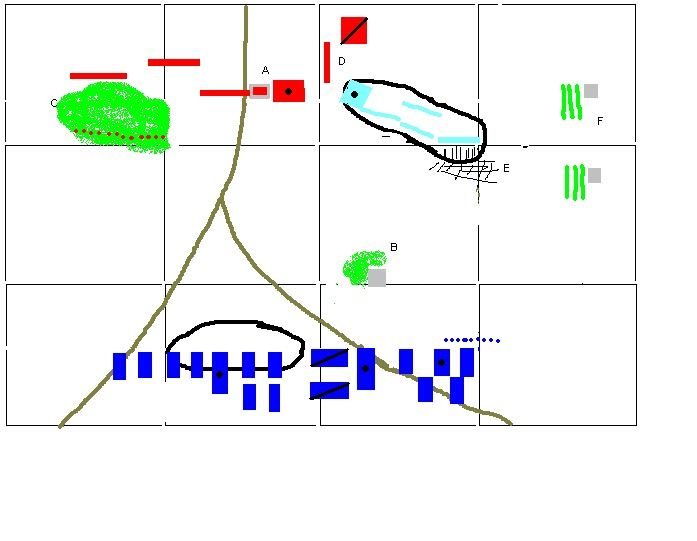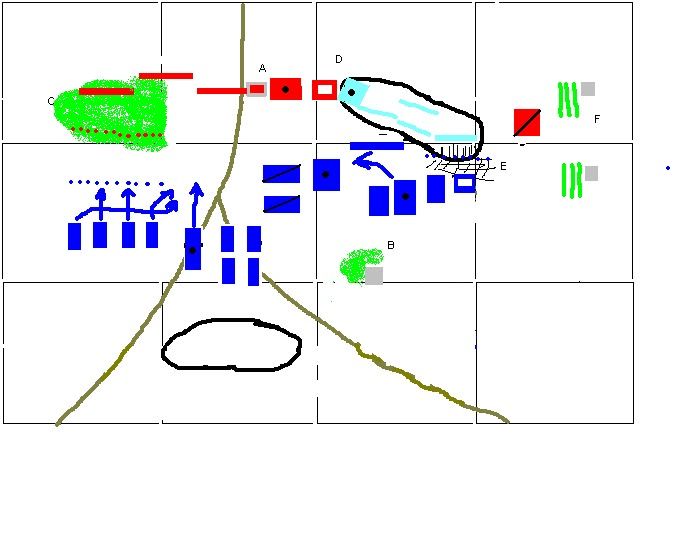I will post a report in parts (to fit around my parental duties tonight).
An Anglo-Portuguese force, comprising a good number of veteran units, was occupying a series of defensive features in an attempt to halt a numerically larger but qualitatively inferior French force. Both commanders, General Sir Arthur Sandwich and Jean Bidet-Arras were Skilled, allowing a lot more scope for manoeuvres than our last game.
The game was played with 15mm figures.

The aproximate dispositions are as above (a little inaccurate in places due to my inferior computing kills).
A: a Class B size 2 BUA – the church and walled graveyard of Santo Placido de Dingo. This can hold a garrison of 6 combat groups and can be assailed by a maximum of 20 combat groups at any one time.
B: a Class A size 1BUA – a small farmhouse. Can hold 3 combat groups (maximum 6 assailing combat groups). Surrounding this is a small copse of open woods (50% movement).
C: Open woods.
D: a medium height ridge with gentle slope except for the area behind broken ground (E). The slope here is steep 25% movement and impassable to artillery. The broken ground will count as soft cover and impede movement by 50% to infantry, 75% to other troops.
F: Vineyards and buildings.

View of the British from the French lines
British OOB
Commander: Major General Sir Arthur Sandwich: Skillful (some of his troops might say "Arfa-Sandwich")
British Infantry Brigade - Seasoned
1x 40 Veteran Infantry
2x 40 Drilled Infantry
2x 30 Veteran Infantry
1x Veteran Battery (3 nine pounders)
Detachment of 95th Rifles : 20 troops (veteran). This will allow you 8 skirmish pairs and 1 combat group of formed troops.
Portuguese Brigade - Seasoned
3x 30 Drilled Infantry
1x 30 Recruits
1x Drilled Battery (3 six pounders).
Unbrigaded Cavalry (Unsure whether they need a rating yet. If so, they will be Inspired)
1x 18 Hussars - Veterans

The British centre and Right (the detachmnt of 95th rifles are in the woods).
French OOB: General de Division Jean Bidet d'Aras: Skillful
1st Infantry Brigade - Inspired
2x 36 Veteran Legere
2x 36 Drilled Ligne
1x Drilled Battery (4 eight pounders)
2nd Infantry Brigade - Seasoned
1x 36 Drilled Legere
3x 36 Drilled Ligne
1x Drilled Battery (4 eight pounders)
3rd Infantry Brigade - Seasoned
2x 36 Drilled Ligne
2x 36 Recruit Ligne
Light Cavalry Brigade - Seasoned
16 Drilled Hussars (3rd Provisional Regiment - can therefore have all different uniforms)
16 Drilled Chasseurs a Cheval
1x Drilled Horse Artillery Battery (3 four pounders)

View of the ridge held by the Portuguese.
Part 2 to follow.....












